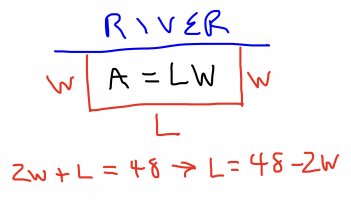eddy2017
Elite Member
- Joined
- Oct 27, 2017
- Messages
- 2,525
Hi, by now I know you know i hate to be in doubt and not be able to find an explanation for a mathematical reasoning applied to something. This might a stupid problem, but i am not getting something here and i will ask you.
A rancher has 48 meters of wire to make a pen for his cows. Since his property is next to a river, what is the largest rectangular area he can fence if he uses the river as one side for the enclosure?.
this is the answer given:
In order to solve this type of problems we apply a division.
48 mts total
15 * 2 = 30 mts
9 * 2 = 18 mts
This would be the largest area you can fence with that length to make a rectangle 15 mts and 9 mts.
I do not get the reasoning.
Only that 15+9=48 but why the multiplication by 2 of each number?.
Thanks,
eddy
A rancher has 48 meters of wire to make a pen for his cows. Since his property is next to a river, what is the largest rectangular area he can fence if he uses the river as one side for the enclosure?.
this is the answer given:
In order to solve this type of problems we apply a division.
48 mts total
15 * 2 = 30 mts
9 * 2 = 18 mts
This would be the largest area you can fence with that length to make a rectangle 15 mts and 9 mts.
I do not get the reasoning.
Only that 15+9=48 but why the multiplication by 2 of each number?.
Thanks,
eddy

